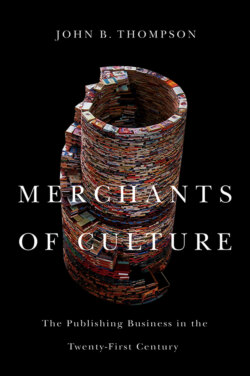Читать книгу Merchants of Culture - John B. Thompson - Страница 11
PREFACE TO THE FIRST EDITION
ОглавлениеIt is a matter of some puzzlement that the one sector of the creative industries about which we know very little is the sector that has been with us for the longest time – the book publishing industry. First established in the fifteenth century thanks to the celebrated inventions of a goldsmith in Mainz, the printing and publishing of books is a business that has been around for more than half a millennium, and yet we know very little about how this industry is organized today and how it is changing. Books continue to command a good deal of attention in newspapers, radio and other media; they remain a staple source of inspiration and raw material for films and other forms of popular entertainment; and writers – especially novelists, historians and scientists – are still endowed with a stature in our societies, an aura even, that is accorded to few other professions. But on the rare occasions when the publishing industry itself comes under public scrutiny, more often than not it is because another journalist is eager to announce that, with the coming of the digital age, the publishing industry as we know it is doomed. Few industries have had their death foretold more frequently than the book publishing industry, and yet somehow, miraculously, it seems to have survived them all – at least till now.
It was partly with the aim of filling this lacuna in our understanding that I set out, nearly a decade ago, to study systematically the contemporary book publishing industry. I began by working on a sector of the industry that was close to my own world as an academic – namely, the field of academic publishing, which included the university presses, the commercial academic publishers (like Taylor & Francis, Palgrave Macmillan and SAGE Publications) and the college textbook publishers (like Pearson and McGraw-Hill). The results of that research were published in 2005 in Books in the Digital Age. Since then I have immersed myself in a very different world – that of general interest trade publishing, the world of bestsellers like Dan Brown’s The Da Vinci Code and Rhonda Byrne’s The Secret, of brand-name authors like Stephen King and John Grisham, of the many styles and genres of fiction and non-fiction, from commercial to literary, from misery memoir to serious history, politics and current affairs. I have studied this world in the way that an anthropologist would study the practices of a tribe inhabiting some remote island in the South Pacific, only in this case the tribe lives and works, for the most part, in a small section of an island squeezed between the Hudson and East rivers in New York and on the banks of the Thames in London. Their practices may initially strike the outside observer as strange, even at times bizarre. But the assumption underlying my work is that once we understand the structure of this world and how it has evolved over time, even the most surprising things do not seem so strange after all.
The research for this book was carried out over a period of four years, from 2005 to 2009; I am grateful to the Economic and Social Research Council (ESRC) in the UK for a generous grant (RES-000-22-1292) which supported this research and enabled me to spend extended periods of time in New York and London. During this time I carried out around 280 interviews with senior executives, publishers, editors, sales directors, marketing directors, publicists and other managers and employees in many publishing firms, from the large corporations to the small indie presses; I also interviewed many agents, authors and booksellers, including some of the central buyers from the large retail chains. I am grateful to all of these individuals for being so generous with their time – and in some cases allowing me to interview them more than once. In a world where time is calibrated as carefully as money, I am very conscious of the fact that I was showered with temporal gifts. Their willingness to participate, their patient explanations of what they do and how they do it and their frank assessments of the challenges they face were the indispensable bases on which I have built my account of their world. For the most part, my interviewees remain anonymous; there are a few cases where I’ve allowed them, with their permission, to speak in their own name when I felt it would be helpful for the reader (or easy for a reader with any knowledge of the field to recognize who they were). But the fact that most of my sources remain anonymous, and that they and their companies are usually given pseudonyms, should not be allowed to obscure the magnitude of my debt.
I could not have completed this book without the generous assistance of Alanna Ivin and her assistants, who transcribed many hours of interviews with unstinting determination and professionalism. I am very grateful to Michael Schudson, Angus Phillips, William Shinker, Helen Fraser, Drake McFeely, Andrea Drugan, four anonymous readers for the ESRC and several of my interviewees – who shall also remain anonymous – who set aside the time to read an earlier draft of this text and provided me with many helpful comments. I am also grateful to Ann Bone for her skilful and meticulous copy-editing, to David Drummond for his inspired cover design and to the many people at Polity – including Gill Motley, Sue Pope, Sarah Lambert, Neil de Cort, Clare Ansell, Sarah Dodgson, Breffni O’Connor, Marianne Rutter and Colin Robinson – who steered this book through the publication process. My thanks, finally, to Mirca and Alex, who helped to create the space for this book to be written and who, in the case of Alex, never ceased to remind me of the primordial joy of reading books.
